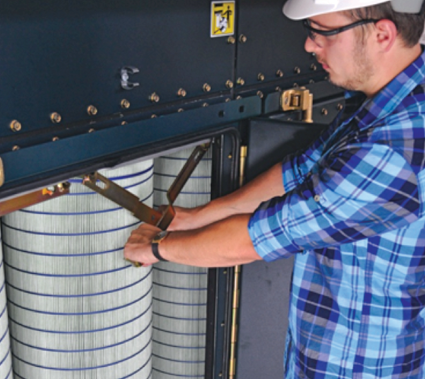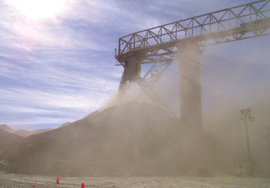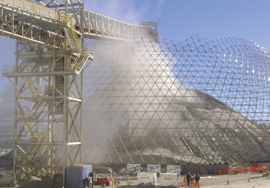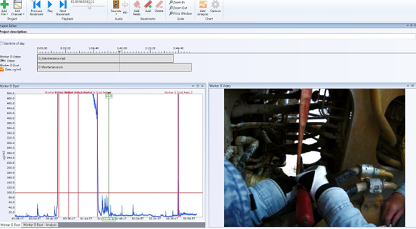Australian Diversified Engineering claims that its ECO Spray system can deliver the optimum volume of water onto haul roads, consistent with current conditions.
Without appropriate control measures in place, dust can be all-pervasive. The days when society was prepared to tolerate fugitive emissions from industrial plants of any description are long gone, and there is also a better understanding of the damage that exposure to dust can do to people and machinery alike.
There are essentially two threads to the dust story: internal and external. Within a mine, quarry or mineral processing plant, the principal concerns revolve around personal health, maintenance and — in dry locations in particular — visibility issues. Beyond the mine boundaries, the nuisance caused by fugitive dust can have a major effect on relations between the operator and local communities, with problems likely to increase further if the dust itself is not completely inert.
Dust Control Basics
Operations typically seek to control dust emissions by either applying an agent — usually water — or enclosing the source. Both options cost money to implement, but as Dr. Mark Kestner, president of National Environmental Service Co. (NESCO), pointed out, there are other ways of addressing the problem that need not cost a penny. “One of the most effective tools that you can use to control dust is good operating practice” is his watchword.
When it comes to haulage, Kestner said, slow the trucks down, especially if there is likely to be a delay before they can unload at a crusher. Slower trucks generate less dust. Reduce the height of stockpiles — lower piles are less affected by the wind. Choke-feed primary crushers — this will generate less dust than a crusher that is handling fluctuating loads.
And, most importantly of all, he added, dust control is everybody’s business on-site, with a strong dust-control culture essential right through an operation’s management and operator hierarchy. “Good operating practice means training operators to take personal responsibility for minimizing dust,” Kestner stated. “Training them to do so is barely a blip in the budget and can have a big payoff.
“Do the least expensive things first,” he added. “You’ll find that the savings go a long way in reducing the costs of more expensive controls like chemical suppressants and dry collection systems.”
Aside from stating the obvious, NESCO’s business includes the supply of DustPro dust-control spray systems. Operating at 200 psi, these produce a highly atomized mist to suppress airborne dust and minimize water addition rates. DustPro systems are electronically controlled, can be completely automated and winterized for use in cold climates. For metals mines, the duplex version is designed with two pumps, one operational and one spare that can kick in immediately if a maintenance issue arises, thereby avoiding any production downtime.
The Benefits of Cartridge Collectors
According to Camfil Air Pollution Control (Camfil APC), its Farr Gold Series dust and fume collector combine enhanced performance with ease of service and reliability for a cleaner workplace. Applications include primary, secondary and tertiary crushing, high-pressure grinding roll crushers, screening plants, conveyor transfer points, stockpiles and ore-storage bins, electrical switchgear and control rooms, and assay labs.
The Farr Gold Series dust collector has a rugged, compact, modular design that optimizes field flexibility and integrates well with conveyor bin vents, the company noted. They have a much smaller footprint than a conventional baghouse and operate at a lower pressure drop, leading to lower energy costs. The pleated filters are mounted vertically inside the collector, eliminating the problems of dust blinding and premature failure that sometimes occur with horizontally installed filters.
In addition, Camfil reported that its HemiPleat high-efficiency cartridges and a cross-flow inlet design allow Farr Gold Series collectors to handle very heavy loads that horizontal cartridges cannot.
Camfil pointed out that although its filter cartridges are more expensive initially than conventional baghouse filter bags, they last much longer and fewer of them are needed. Hence, downtime for maintenance is reduced. In consequence, total annual installation and operating costs can be markedly lower.

According to Camfil, filter change-out with its Farr Gold Series dust collectors is simple and easy.
Geometrica’s Domes
With facilities in Houston, Texas, and Monterrey, Mexico, Geometrica has been constructing its domes and space-frame structures since 1992. The company noted that these offer an alternative approach to dust control, particularly for applications such as stockpiles.
The company pointed out that traditional building methods are often not practical or cost-effective, especially in remote and rugged regions. Steep slopes or corrosive saltwater environments require more than conventional building systems, Geometrica said, with its system offering lightweight, strong domes and barrel vaults. Structures that can span up to 300 m without internal columns, these can also be built over and around irregular shapes and live operations.
Geometrica cited the example of the Freedome that it supplied to Minera Coemin to cover the crushing and conveying equipment at its Carola mine in Chile, as a means of preventing dust emissions. The challenge at this particular site was that the crushing plant had been expanded several times, resulting in a highly irregular footprint that needed covering.
The company’s solution was to design a freestyle dome covering some 5,000 m2 while bridging existing buildings without needing modifications to the crushing and screening plant. The heart-shaped result included 90-m spans in the principal directions.
Dome construction progressed upward, with the partly built dome supporting its own weight and that of the construction crews. No scaffolding was needed, nor was there any operating downtime. Cladding consisted of corrugated metal sheets with a polyester finish.
Carefully Measured Control
Australian Diversified Engineering (ADE) claims to offer the only system in the world that can deliver consistent, measurable water coverage for dust suppression on haul roads. This, the company said, has the potential to save millions of dollars and billions of liters of water every year, while also increasing truck productivity.
ADE specializes in water truck spray systems for haul-road dust suppression. This is a precise art — if too much water is sprayed, the road can become slippery, while with too little water, dust can obscure the road. The company’s Electronically Controlled Operating (ECO) Spray system uses technology to measure the truck’s ground speed, the road surface material, the road geometry and other factors to calculate and supply the ideal amount of water to the road.
ADE suggested that on sites where water typically costs around A$2,000 per million liters ($1,500), using the ECO system, a fleet of five trucks operating 18 hours per day can save 4 million liters of water per day, or 1.4 billion liters per year — a monetary savings of A$2.9 million (more than $2 million).
 |
 |
 |
| Three stages of Geometrica’s Zaldívar project: the problem | dome construction | final dust containment |
Lignins and Latex
With its headquarters in Ohio, Zinkan Enterprises offers ranges of dust-control products that can address emissions in underground and surface mining, stockpiles, rail transport and road surfaces.
Zinkan’s dust control products include its MineReady range for underground and surface applications, PileReady for stockpiles, RailReady for transport, and DustReady for haul roads. For example, RailReady-50 is a water- and latex-based sealing agent used for stabilizing materials such as coal to reduce losses during transit or storage. It penetrates the material surfaces, forming a tough water-resistant crust. A winterized version is also available.
For haul roads, DustReady-110 is a natural byproduct from trees, made primarily of lignin, the natural polymer that binds tree fibers together. Applied annually to roadways and commercial yards to stabilize and improve the quality of the road surfaces and to control dust, it is non-corrosive. DustReady-110 is applied as a liquid and dries to a hard durable surface that controls dust and increases the load-bearing capacity. As a binder, it reduces gravel losses and grading requirements, thus lowering overall road maintenance costs, the company stated.

The crust formed on a coal stockpile treated with Zinkan’s PileReady, a week after the sprayed application.
Roadside Sign Dust Removal
While dust problems are often considered in terms of airborne material or bulky accumulations, the effect of dust on road signs and haulage markers is often overlooked. Spinflector Industries believes it may have a solution to what it explains can be a long-term, high-cost challenge.
The Spinflector itself is a wind-powered device that automatically cleans the reflectors on the delineator posts used to mark haulage routes and other features in surface mines. With a big mine often using 10,000-15,000 individual marker posts, manually cleaning dust and grime from the reflectors can involve teams of workers traveling almost weekly along major thoroughfares, creating safety issues, loss of productivity and additional labor costs.
The Spinflector is designed to fit on a 50-mm PVC delineator post and contains a series of brushes to clean dust and grime from reflectors. The device has a built-in wind vane to power the brushes, with the company claiming it only needs to rotate half a dozen times in a 48-hour period to take off the layer of dust and be effective.
According to Spinflector Industries, it has trialed the system at an iron ore mine in South Australia for five months without incident, and without the need for any manual cleaning of roadside reflectors.

The Spinflector is designed to clean haulage marker reflectors automatically.
Getting a Clear Picture of Dust
By Donna Schmidt, Field Editor







